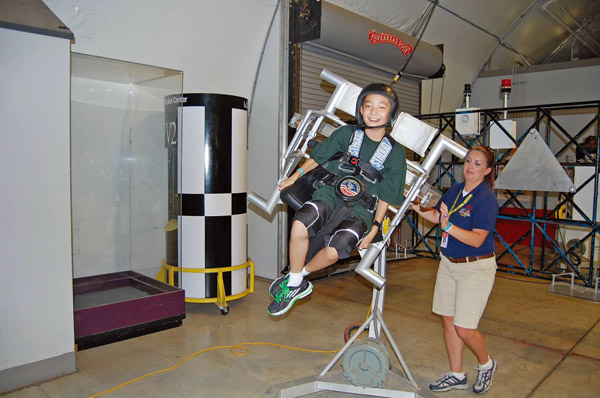An out-of-this-world opportunity for future astronauts
Updated: 2012-05-09 10:53
By Wang Ru (China Daily)
|
|||||||||||
 |
|
Edward Buckbee (left) with Wernher von Braun in 1969. Photos Provided to China Daily |
 |
|
A Chinese student receives training at the space camp of the Space & Rocket Center, Huntsville, Alabama, US. |
He's a rocket scientist who has faced tough questions from veteran journalists from around the world, so he was surprised when a Chinese 7th grader stumped him.
US Space & Rocket Center director Edward Buckbee didn't have an answer for the teenager at Tianjin's Nankai Middle School, who asked, "How can astronauts swallow food in space?"
Buckbee was delighted.
"That's the reason I am always excited to talk with these smart, knowledgeable and enthusiastic young Chinese students, and introduce them to aerospace history and open their vision in the United States," he says.
Buckbee has recruited Chinese students for an international space camp at the Space & Rocket Center in Huntsville, Alabama, since 2002. More than 600 Chinese students a year have flown across the world to enjoy the camp with youths from all corners of the globe.
In 2011, China's space heroes Yang Liwei (the first Chinese in space ) and Zhai Zhigang (the first Chinese to carry out a space walk) sent their sons to the Huntsvilla camp.
"Just like the US in the 1960s, China, in the recent decade, has made impressive developments in aerospace," Buckbee says.
"I am excited to see the country's determination to explore space."
Buckbee became an early participant of the US' golden age of aerospace.
He was the public relations officer of Wernher von Braun, whom some in NASA consider history's greatest rocket scientist.
Buckbee won the Wernher von Braun gold medal in April for his achievements in promoting space travel.
"Without a doubt, China will have leading scientists like Von Braun, who can boost the space dreams of human beings in the future."
This year is the 100th birth anniversary of Von Braun, the German rocket scientist, who designed the V-2 combat rocket in Nazi Germany during World War II. He later moved to the US, where he developed Saturn V, the super-booster that propelled the Apollo spacecraft to the moon in 1969.
From 1950, Von Braun and other leading rocket scientists were transferred to the Redstone Arsenal army base near Huntsville, which hosts Marshall Space Flight Center (MSFC), US aerospace's cradle and nerve center.
Von Braun was director of MSFC when he had an idea of creating a museum with the US Army Missile Command and NASA.
Nearly 16 million people have toured the US Space & Rocket Center since it opened to the public in 1970.
The vast majority of visitors are from out of state or foreign countries.
Von Braun called the Space & Rocket Center, "the finest of its kind in the world" and continued to be a firm supporter even after leaving Huntsville for a high-level NASA position in Washington.
Dozens of exhibits involve visitor participation, prompting one official to say: "Here, everyone can be an astronaut for the day."
The US Space & Rocket Center houses thousands of artifacts, including the charred Apollo 16 Command Module, a rock brought back from the moon, the original Saturn V lunar rocket vehicle and a full-sized space shuttle mock-up.
It is also the home of Space Camp, the world's pre-eminent youth science program. More than half a million young people and adults from around the world have participated in the camp's astronaut training since the program began in 1982.
Space Camp is designed to encourage young people to pursue careers in science, math, engineering, robotics and aerospace industries by giving them a firsthand introduction to the space program.
The overseas summer camp is a booming market in China. In 2010, more than 50,000 Chinese students went to the US for various summer camps.
"The summer camp in Huntsville is distinctive and welcomes thousands of students from all over the world," Buckbee says. "It is designed to inspire young people's enthusiasm for science, teamwork and the ability to cope with challenges."
Related Stories
A novel approach 2012-03-09 13:23
Space Theme Park to lure tourists to Inland Hainan 2011-05-06 16:38
New space for ancient place 2011-02-15 07:52
Chinese scientists sequence sweet orange genome 2012-04-23 09:32
Making science pop 2012-03-21 14:00
Today's Top News
Rescuers race against time for quake victims
Telecom workers restore links
Coal mine blast kills 18 in Jilin
Intl scholarship puts China on the map
More bird flu patients discharged
Gold loses sheen, but still a safe bet
US 'turns blind eye to human rights'
Telecom workers restore links
Hot Topics
Lunar probe , China growth forecasts, Emission rules get tougher, China seen through 'colored lens', International board,
Editor's Picks

|

|

|

|

|

|





